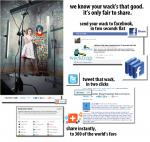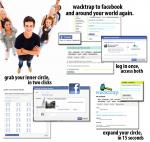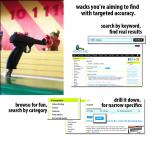What’s your story?
Share and find customer experiences
Connect with the people behind them
Wacktrap is
feedback made social
Trending Content
LEN Technology Battles Credit Card Skimming Scams and Fraud
by hearit
The US has got at least one thing to learn from Europe: New Zealands’ BNZ bank has gained global patents for its technology to combat bank or Credit Card Skimming scams by 50%--US customers, banks and credit card companies lose billions in scams involving credit and bank card fraud including skimming—where a card’s magnetic strip is scanned or stolen using pocket reader or skimming machines.
Credit card skimming is the fastest-growing electronic fraud risk for consumers and issuing banks. A spokesman for the bank says both local and international organizations had expressed interest in licensing the new technology to combat Credit Card Skimming fraud—a technology two years in development and testing.
As of now, no transcontinental deals have been brokered for the technology that could save credit card consumers and their card companies billions. BNZ parent company, National Australia Bank, is currently evaluating the technology which is has yet to adopt it for bank customers.
Credit Card Skimming or bank card skimming occurs when the credit card or bank card holder’s information contained on the card's magnetic stripe is captured without a customer’s knowledge. In the United States, some of the most notorious card skimming scams have involved restaurant waitresses or servers who carry a “pocket reader” card skimming machine, scanning the magnetic stripe before running the customer’s card for the actual bill.
Credit card skimming devices have also been placed by thieves over the real card reader at services like gas stations and even ATM machines—including a Citibank ATM on the West Coast--where instead of pumping gas or getting cash, customers are actually unknowingly swiping their bank or credit cards through a skimming machine device that’s stealing their info and card numbers. When the credit card is scanned, the customer’s credit card number can be fraudulently used by the person actually scanning the card magnetically—or sold on the black market.
One of the United States’ most notorious recent credit card skimming scams involved restaurant chain PF Chang’s. Chibuzo Okafor, 24, of Rosedale, New York, waived her right to be indicted and instead pleaded guilty only months ago in March—the PF Chang’s employee admitting guilt to one count of conspiracy to commit access device fraud. Court statements say that the restaurant employee, Okafor, worked as a waitress [server] from September 2008 to January 2009--at a P.F. Chang’s restaurant location in Stamford, Connecticut. Prior to taking that job at PF Chang’s, the employee worked at Grand Lux Cafe in New York. In the guilty plea, Okafor admitted that she and a co-worker stole credit card information from customers through the use of “skimming” devices—while working at both restaurants.
When restaurant customers would pay with their credit cards, Okafor and her co-worker would swipe the cards through hand-held skimmers (also known as pocket readers)—to steal cardholder information contained on the credit card’s magnetic stripe--before running the credit cards through the restaurant’s own legitimate credit card verification system. The skimming devices would copy and store the credit card holder’s account information encoded on the magnetic strips on the back of the credit cards. Every few weeks, a separate individual who supplied the skimming devices to the PF Chang’s employees or servers would meet with Okafor or her co-worker--so that the restaurant chain’s employees could turn over to him the credit card information stored on the skimming devices, that had been stolen from the physical credit cards the servers had handled.
That individual, or ringleader heading the credit card scam, would then pay the PF Chang’s employees either $20 or $25 for each bank or credit card employees successfully swiped through the illegal skimming device—then swapping out and providing the restaurant servers with new credit card skimmers so that employees could continue with the fraudulent scam. The stolen credit card information was later used by members of the conspiracy--to make unauthorized credit card purchases with the stolen card numbers.
While Okafor was employed at P.F. Chang’s, approximately 92 credit cards were compromised in relation to her involvement in the scam—resulting in financial credit card losses of approximately $147,220. Additional financial losses have been attributed to the conspiracy earlier in 2008, when Okafor was employed at the Grand Lux Cafe. That PF Chang’s former employee faces up to 5 years in prison—the PF Chang’s server hasn’t been the only involved in the credit card skimming scam concerning the restaurant, with at least one Los Angeles county location also involved in a separate waiter skimming scam.
On the West Coast, and prior to the Okafor PF Chang's restaurant employee involvement in the credit card fraud, eight restaurant employees from different So Cal restaurants were found to be selling skimmed credit card numbers at $200 apiece—causing a financial loss of approximately a million dollars in the scam.
Recently, four waiters at three different restaurants within blocks of the White House were busted in a credit card skimming ring and scam. Crooks made off with roughly $750,000 worth in fraudulent bank debit or credit card charges.
In 2007 police in England found 27 credit card or bank card skimming machines installed on its London Underground ticket machines alone. Skimming is made slightly more challenging in the UK, compared to the United States. Since Europe’s introduction of ‘Chip and Pin’ bank and credit cards, the extra layer of security has cut down on fraud. The chip and pin credit or bank cards have been largely instituted in place of magnetic strip cards, technologies used across Europe--but the United States has yet to invest in or change over the magnetic strip technology.
The new LEN technology to combat Credit Card Skimming, using an enhanced security method invented and developed in New Zealand by BNZ—uses a security technology called Liquid Encryption Numbers (LEN) which works on a dynamic versus static display of bank or credit card customer information. “On standard bank and credit cards, the information stored on the magnetic strips is static and doesn’t change,” BNZ spokesperson Turner, who helped develop the LEN technology, says. “With Liquid Encryption Numbers (LEN), we’ve made that [credit card information contained on the magnetic strip] information dynamic so that it changes every time a customer visits a BNZ [company] ATM – this means if criminals copy the data [of consumers] on the [bank] cards they [crooks] won’t be able to use it for fraud,” Turner says.
“We believe this to be a world first and we invented it here [in New Zealand, at BNZ]” says BNZ CIO Peter Yarrington. Both Europe and New Zealand are a bit ahead of the game in terms of credit card and bank card security, already phasing out the magnetic strip-only bank cards and replacing them with the Liquid Encryption Numbers chip cards.
A BNZ company representative says magnetic strip credit or bank cards probably had another 10 years left in the United States, as they're far more cost efficient than chip cards. The new LEN technology works with magnetic cards or chip cards—should hackers find a way to violate the more expensive chip bank cards. The Liquid Encryption Numbers technology also aid in a bank or financial institution being able to pinpoint where the bank card data was actually stolen, says BNZ’s Yarrington. Also, if a bank detects that a Liquid Encryption Numbers-enabled bank card has been compromised but not yet fraudulently used, the bank card doesn’t need to be blocked, says Yarrington—ordering new cards being one of the biggest inconviences to bank or credit card customers. “Instead, we can just ask customers to visit a BNZ [company] ATM [machine] where their [bank] cards can be secured by updating the LEN – this is a simple, automatic process, with minimal inconvenience to customers,” says Yarrington.
The Liquid Encryption Numbers bank and credit card technology has been rolled out to New Zealand customers for the past two years--and BNZ says its seen bank fraud numbers decrease by at least 50%. “Since the implementation of LEN [financial] losses from the most common form of card fraud have more than halved,” BNZ’s Yarrington said. United States credit card fraud was estimated at over 50 billion several years ago and has been on the rise—in an instance where the United States could learn from Europe in preventing bank and card fraud through instituting better or more secure technology.
Location
SPEED UP YOUR ONLINE GROWTH
How To Wack
Take the Tour
Click on any image to start











